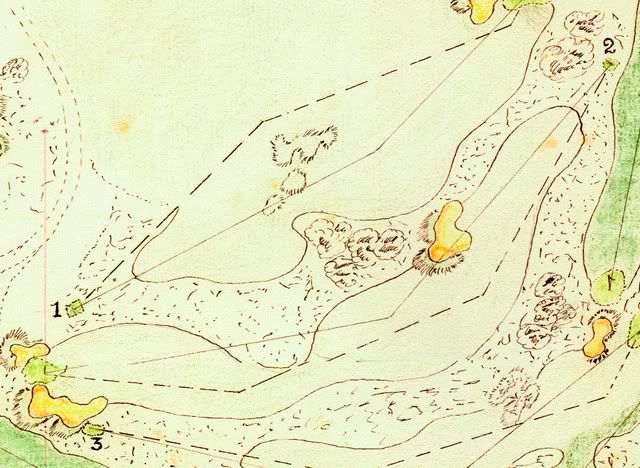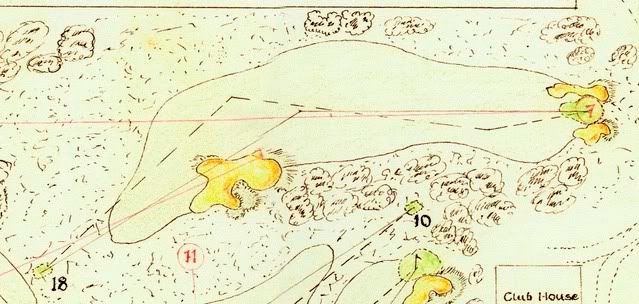Justin
Firstly there is no qualification necessary to be a golf course architect as its not a regulated profession like architecture, engineering, medicine or the law. If you can convince a client to give you some work you can call yourself a golf course architect. It just seemed curious that both Mike and I, who do this for a living, apparently did not get Chris' main point.
I can't see how on reading Mike's last post that you can take that to support Chris' thesis. Certainly there are holes that can't easily be lengthened to bring the bunkers into play for decent players from the tee. There is still plenty of overall hole strategies on these holes regardless of whether the bunkers are in play or not. I thought it would be a good exercise to go back to the early plans and see what it was that Mackenzie and Russell intended for these holes. I've looked at the two coloured plans in RM's possession, as well as the routing plan published in "The Sporting Globe" newspaper in Melbourne on January 21, 1931 which accompanied a review of the about to open West Course by experienced golf writer Jack Dillon, a man who interviewed Mackenzie a number of times back in 1926 and knew Russell well. Some of his comments are also quite enlightening.
Examination of these plans for holes 2, 4 and 18 show that the fairway bunkers on these holes were planned to be easily carryable even then. They were never at the limit of the drive - THEY WERE NEVER MEANT TO TRAP GOOD PLAYERS DRIVES! Right from day one! So how Chris and Justin can suggest that is a weakness today is unsustainable if they were never intended to do that task back in 1926. Please see the holes I've extracted from one of the coloured plans and the newspaper report and see what you think. I believe these address Chris' thesis directly, without a red herring in sight!
Coloured plan (hanging on wall of clubhouse) of Hole 2. The solid line is presumably the good player's line while the dashed line is that of the shorter hitter.

Sporting Globe plan of Hole 2 just prior to opening

Coloured plan of Hole 4

Sporting Globe plan of Hole 4

Coloured plan of Hole 18

Sporting Globe plan of Hole 18

Since I wrote this text last night I notice that Matthew Mollica and Matthew Delahunty have also made posts critical of Chris' thesis. Perhaps they didn't get the point either!
And to finish with, some extracts from Jack Dillon's 1931 article in which he discusses the 4th hole:
"To Ivo Whitton was given the credit for many of the features of the fourth hole (448 - 394 yards) by Alex Russell. This is, perhaps, the best hole on the course, It is distinctly dog leg, with a big, natural hazard up on the rise on the right to be carried from the tee, and as much of the corner near the woods has to be cut off as is safe."
He later concludes that:
"The single feature that made the biggest appeal to me was the contouring and undulating of the turf on the ideal spot to which the drive over the rise to the 448 yard fourth should be sent. From this location there will usually be required a wooden club, but the ball will be lying on on an up or a down slope. or the stance will not be quite normal, or the ball will be above or below the feet. This feature contributes considerably to the making of this hole the best on the course."
Dillon is describing the contour hazard of the 4th fairway in the landing area as the making of this hole - not the hazard to be carried from the tee. Clearly the fairway bunker was viewed then as secondary, as it is today.
Dillon also made some general remarks about the bunkering of the West Course, saying that:
"Shaping of the fairways and rough has been most intriguingly, pointedly and attractively done, and thereby has the need for trapping, particularly through the green, been made unnecessary to a notable degree. The economy of bunkering, most marked around the greens, is a big feature of the layout. Every natural point of the country has been marshalled to do its work, and the actual making of traps has thus been reduced considerably."
His remarks about the uniqueness of the West Course are worth repeating:
"While great courses like Metropolitan, Commonwealth and the others named above (Kingston Heath, Victoria, Yarra Yarra and Woodlands), are in many respects quite separate, and have personalities of their own, there is undoubtedly a similarity, and they may be included, with the possible exception of Commonwealth, in the same class of links archtecture. The West Course at Royal Melbourne - to date I have not had an opportunity of seeing in detail, even in the rough, The East Course, which I am informed on the best authority will be the equal of its twin - has a character and personality all its own in golf in Australia.
Essentially this character comes from the manner of the making of the new course. Mostly in the cases of the holes of the other courses, the bunkering and features were added to the holes. At The West Course the holes were superimposed on locations selected as ideal for those holes. Natural golfing features on simply wonderful seaside golfing country (possibly this is melbourne's first seaside lay-out) were seized upon with brilliant skill, and in the making exploited to a degree that has not anywhere else here been equalled. Above all the holes look natural."
Dillon suggests that:
"However, I am convinced that the links which will universally be classed as the finest golfing possession Australia has, is one that is not yet included for playing purposes in our game.....Definitely Australia is soon to see in play the finest championship layout in the land. That lay-out is The West Course of the Royal Melbourne Golf Club at Sandringham. It will be opened for play about the middle of this year."
A big call to rate a course that had not even opened the best in the land, but time has proven that Jack Dillon was right on the mark.